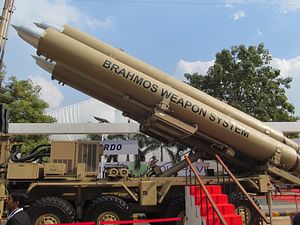After much chatter going back to 2019, it is finally a done deal: Earlier this month, the Philippines announced that it had inked an agreement worth $375 million to procure the Indo-Russian BrahMos anti-ship missile and its supporting assets. The mainstream argument is that the supersonic weapon will improve Manila’s anemic defense capabilities, especially as the Armed Forces of the Philippines (AFP) increasingly faces up to the Chinese military juggernaut. Making an observation along this line, one commentator noted that the BrahMos would provide a “stiff deterrent” to Beijing’s assertiveness in the South China Sea. Similarly, another observer argues that having the BrahMos “will significantly supplement the defense capabilities of the Philippines by enabling it to strike seaborne or surface targets at a considerable distance from its shores.”
That said, deterrence is, as the eminent U.S. diplomat Henry Kissinger once put it, a product of capability and resolve, as well as the opponent’s belief in one’s capability and the resolve to use it. Military weapons are an integral element of the first factor. But as long as just one of these three elements is zero, the output will be zero, as one learns from elementary math. Indeed, from an operational point of view, the Philippines’ BrahMos purchase would likely register a low figure in the capability portion of the deterrence equation as long as Manila lacks the requisite sensors to maximize the weapon system’s range. As a consequence, the Philippines’ much-ballyhooed deterrence of China using the BrahMos is likely to be limited.
The range of this missile, according to its manufacturers, is a tidy 290 kilometers, and this has made Philippine navy admiral-turned-academic Rommel Jude Ong join the chorus of mainstream discourse on the issue and contend that the weapon will provide “a defensive buffer across a certain extent of the EEZ (or exclusive economic zone that extends to about 370 km off the coastline).” According to Naval Tactics 101, however, one can shoot only as far and as well as your sensors are able to cue you to, especially with regard to moving targets like warships that need to be pinpointed and constantly tracked. A missile system’s sales-brochure range of hundreds of klicks is for nought when your sensors can only detect and track targets at distances much less than of that.
This is exactly the issue that Manila will face, as the BrahMos launcher’s own radar can only provide coverage merely dozens of kilometers out because of the Earth’s curvature. The AFP lacks over-the-horizon radar that could mitigate the problem, but this lacuna is understandable given that such a capability is accessible usually to larger military powers.
The limitations imposed by the Earth’s curvature could also be mitigated by airborne sensors that provide the militarily important element of “high ground.” However, the Philippine military is severely lacking in the aerial intelligence, surveillance, and reconnaissance (AISR) domain. Crucially, the air force does not have any dedicated airborne warning and control system aircraft like the E-3 Sentry. The Phillippines’ AISR platforms, according to the latest edition of the authoritative Military Balance, include barely a dozen Cessna utility aircraft and OV-10 Bronco light attack and observation planes, which are hardly suited for the demanding tasks of maritime ISR.
While Manila possesses a number of Heron and Blue Horizon surveillance drones, they are simply too small in number – five according to the Military Balance 2021 – to make a difference (and they belong to the air force rather than BrahMos’ future operators, the army, the marines, or the latter’s parent organization, the navy). Moreover, these platforms are slow flying – like most of their kind are – and this makes them essentially hapless in the face of the enemy, especially one with substantial anti-air capabilities such as China.
And even if Manila were to have credible AISR platforms on paper, integrating them with other systems like the BrahMos is another issue together, bearing in mind that the AFP is also lacking in the command and control, communications, and computers department that would be so crucial in enabling network-centric warfare. Indeed, the fact that the Philippine navy entered the missile age only as recently as 2018 is but one symptom of the AFP’s overall backwardness.
All in all, contrary to popular opinion, the BrahMos in Manila’s hands cannot hold potential adversarial warships at risk from long range, even if this particular missile has a near-300-kilometer range on paper according to its developers. At best, the Philippine BrahMos’ engagement envelope is in the vicinity of dozens of kilometers bearing in mind the aforementioned limitations. Retired Philippine general Edilberto Adan is therefore right on point when he stresses the “need for eyes and ears” for a missile system like the BrahMos, adding that the latter “has to be integrated with a surveillance and intelligence capability for the simple reason that what you cannot see or what you cannot detect, you cannot engage.”
As the BrahMos deal earlier this month came to light, perhaps somewhere in China, an informed key member of the People’s Liberation Army Navy was smiling as he nonchalantly crossed the Philippine BrahMos off his list of threats.
However, Mischief Reef, with its Chinese installations, is less than 220 kilometers away from the Philippine shoreline, and it could be accurately targeted as it is a land target whose location is fixed, obviating the need for sensors that are able to detect and track mobile targets beyond the horizon. That, perhaps, is the saving grace of the much-vaulted weapon systems coming into Manila’s hands. The BrahMos would finally enable the AFP to credibly threaten a small but significant element of the Chinese politico-military colossus, without putting Philippine forces in harm’s way.

































